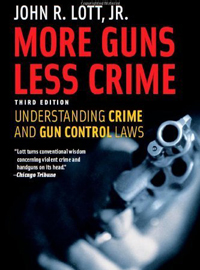| John Lott: More Guns, Still Less Crime |
 |
|
By Timothy H. Lee
Thursday, July 22 2010 |
“I would ask gun control advocates one question: name a single place in the entire world where murder rates fell after gun control laws were passed.” That is the powerful challenge from economist Dr. John Lott, Jr., who was kind enough to discuss with CFIF the third edition release of his tectonic book More Guns, Less Crime. Over a decade has passed since More Guns, Less Crime was released in 1998, immediately remaking the gun rights debate landscape. Lott, who brought an economist’s empiricism to a debate saturated in passion but short on probative data, proposed “a critical review of the existing evidence on gun control and crime.” Accordingly, he asked: “Does allowing people to own or carry guns deter violent crime, or does it simply cause more citizens to harm each other?” Lott’s objective conclusion was controversial in 1998, less so today. Based upon broad data sources and examination of FBI annual crime figures for all 3,054 American counties spanning sixteen years, he found that waiting periods, gun buybacks and background checks “yield virtually no benefits in crime reduction.” In contrast, Lott observed that “of all the methods studied so far by economists, the carrying of concealed handguns appears to be the most cost-effective method for reducing crime.” We’ve now had a decade to digest More Guns, Less Crime. Twelve years can be long and cruel on watershed books, withering them beneath the harsh glare of events and critical analysis. By way of illustration, recall 1999’s Dow 36,000. Not so with More Guns, Less Crime. As stated by Dr. Lott and boldly noted in the preface to the new third edition, not a single antagonist has refuted his empirical conclusion that more firearms result in reduced crime. So what makes a third edition vital? What makes it a critical addition to Americans’ book collections? Plenty. When More Guns, Less Crime was initially published, only eighteen states possessed right-to-carry firearms laws. Today, that number has more than doubled to thirty-nine states. Obviously, that dramatic increase provides an even larger base of data to test Lott’s research. Further, the original edition examined sixteen years of data, 1977 through 1992. The third edition now covers twenty-nine years, which is particularly helpful since so many more states have adopted right-to-carry laws during that interim. Another reason that a third edition is essential is that critics have had twelve years to critique Lott’s proposition. As Lott states, however, “not a single refereed study finds the opposite result, that right-to-carry laws have a bad effect on crime.” Lott’s latest edition also addresses the impact of “Castle Doctrine” laws, which refer to the adage that “a man’s home is his castle” and make it unnecessary for potential crime victims to retreat as far as possible before using a firearm in self-defense. Also addressed by the new third edition is the federal “assault weapons” legislation, which took effect in 1994 but terminated in 2004. Gun control advocates predicted an explosion in murder and violent crime when the ban expired, but rates actually declined substantively. As Lott notes, “rarely do we get a chance to look at the impact of gun laws when they are first passed and then when they are eliminated.” In just the past two years, moreover, the United States Supreme Court has for the first time ruled on the long-debated issue of whether the Second Amendment protects an individual, as opposed to collective, right to keep and bear arms. Immediately following the Court’s District of Columbia v. Heller decision, the Washington, D.C. murder rate fell 25% (compared to a 7% nationwide reduction). Lott notes that the city of Chicago shows the opposite pattern, as the murder rate “exploded” after imposing its 1982 gun ban. In the new third edition, Lott also addresses the inefficacy of such things as waiting periods, mandatory trigger locks and gun show regulations. Each of these regulations raises obstacles for people to defend themselves, thereby making it easier for criminals to prey on weaker citizens with greater confidence. And, as noted above, Dr. Lott has not encountered a single jurisdiction in the entire world where imposing gun control laws triggered a decline in murder rates. The bottom line today, just as was true in 1998, is that “the very rules that seek to save lives can result in more deaths.” Dr. Lott has thus provided an invaluable service to America and the world audience generally. Twelve years of additional experience and mountains of data confirm the empirical truth – more guns in the hands of law-abiding citizens mean less crime. |
Related Articles : |
























